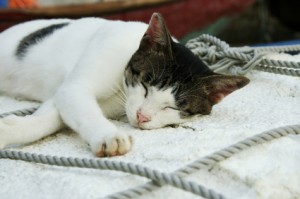 Cats sleep a lot, and thus they have developed several cat sleeping habits. One cat habit is the length of time which a cat spends sleeping. Cats spend a lot of their time asleep—anywhere from 13 to 16 hours—which means that they are actually asleep more often than they are awake. This makes the cat one of the highest ranked sleepers among mammals; not too many other mammals can claim that they spend up to two-thirds of their life asleep.
Cats sleep a lot, and thus they have developed several cat sleeping habits. One cat habit is the length of time which a cat spends sleeping. Cats spend a lot of their time asleep—anywhere from 13 to 16 hours—which means that they are actually asleep more often than they are awake. This makes the cat one of the highest ranked sleepers among mammals; not too many other mammals can claim that they spend up to two-thirds of their life asleep.
There is of course individual variation from cat to cat in the amount of time spend asleep. The length of time spent asleep may be subject to influences such as age, hunger, temperature of the environment, and weather. Many of these factors play into the comfort of the sleeping environment, and sensibly, the less comfortable the surroundings, the less time the cat is likely to spend asleep. Just like a human, a cat has REM cycles. In humans, and likewise probably also in cats, REM cycles are associated with lighter sleep (growth and bodily repair occur during deep sleep). REM is also associated with dreaming, and during periods of REM, the cat’s body will be paralyzed by its brain so that it does not “act out” the dreams. Cats in REM cycles will lay sprawled out or curled up as they sleep. By contrast, a cat sleeping in the “sphinx” pose cannot be dreaming because its muscles are holding it up.
Another cat habit is related to their “crepuscular” sleeping schedule. Many cat owners mistakenly believe that cats are nocturnal animals because they seem to always be awake when the owners get up in the morning. However, cats do the majority of their sleeping during the night and in the middle of the day. The reason is that in the wild, the cats from whom house cats are descended do the majority of their hunting during the dawn and twilight hours, when small prey such as rodents are active. Pet cats still retain this sleep schedule from their ancestors, and are therefore most active themselves around the times when the sun rises and when the sun sets.
Unfortunately, a third habit relates to cats that do become nocturnal. This sometimes occurs for various reasons, but luckily it can be reversed by the pet owner. For instance, if a cat is waking up in anticipation of being fed, and waking up its owner to do the feeding, the owner can subvert the behavior by never feeding a cat immediately upon being woken by it. The association will no longer be reinforced; parents will recognize this notion from sleep training babies. If not fed, the cat will usually go back to sleep. This relates to a fourth sleeping habit, which is typically termed “cat naps” by humans. As the majority of a cat’s sleep is of the light sleep nature, they frequently wake and easily fall back asleep during the sleep cycle. This tendency likely evolved as a defense against predation by other animals. In the wild, a cat that slept heavily too much of the time would have been more likely to be caught by a predator because the cat’s senses would not have alarmed it to the predator’s presence.
A fifth and final sleeping habit of cats relates to the spots they choose in which to sleep. As mentioned above, cats prefer ideal environments in which to bed down. One important criterion that cats look for when finding a place to sleep is the temperature. In the heat, cats will seek shade (picture lions sleeping under trees in the Serengeti), and in cold weather, they will find heat, such as in the light from a window, or next to a radiator. Cats may also decide to sleep with their owners. This serves the dual purpose of socialization with their owners and seeking a comfortable temperature.
Filed under: Cat Habits
Like this post? Subscribe to my RSS feed and get loads more!

Leave a Reply